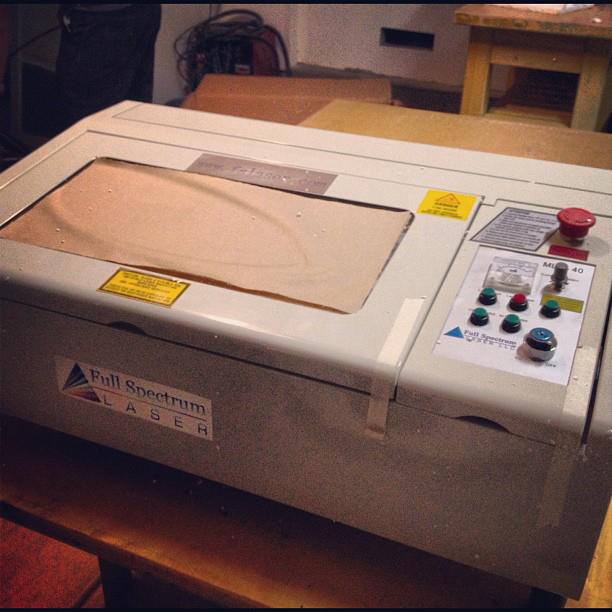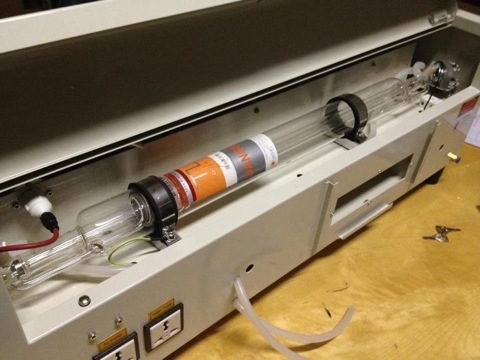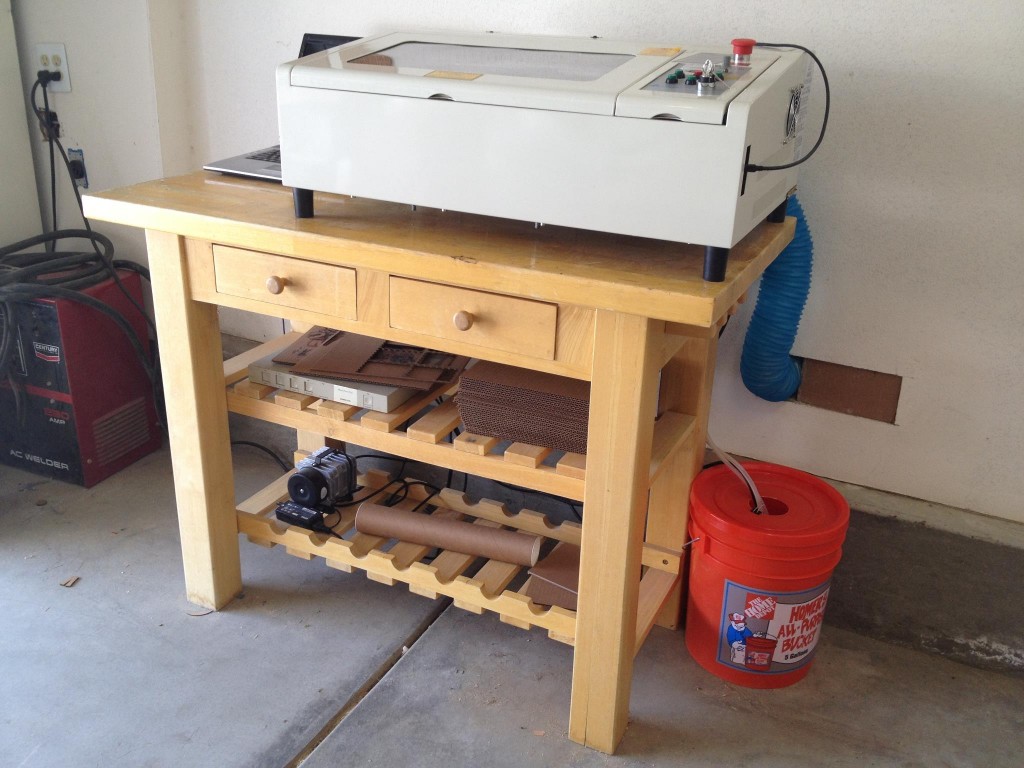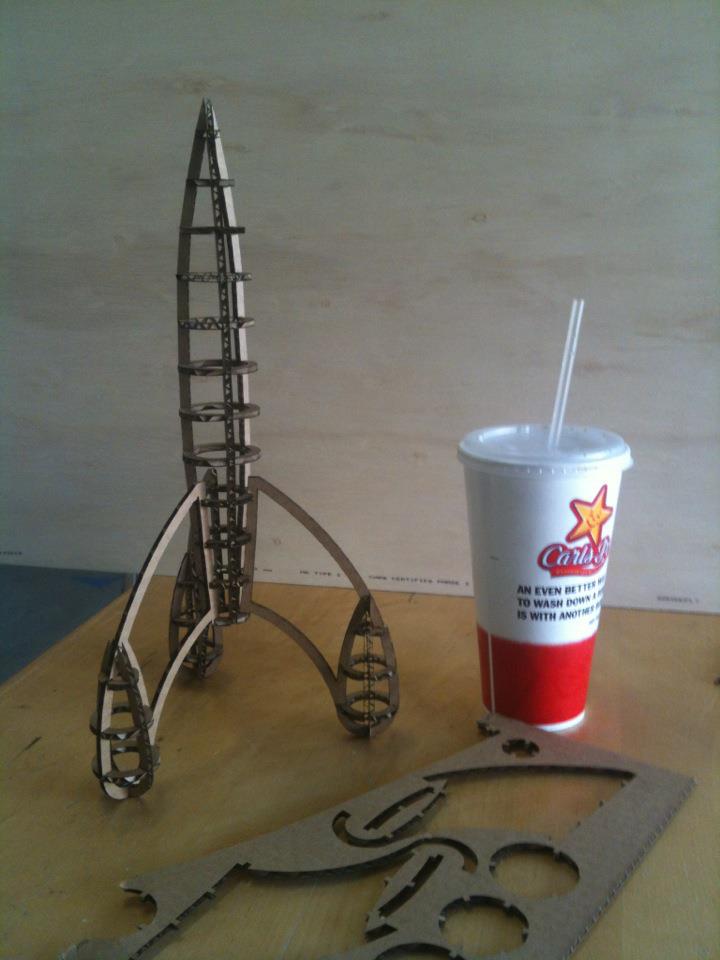After an unexpected tax return came in, I finally decided to get a laser cutter. One had been on my wish list for quite some time, and this was the perfect excuse to take the plunge.
After reading a bunch of online reviews, I decided to buy Full Spectrum’s 40W Deluxe Hobby Laser. After owning and using it for 2 months now, I would definitely consider it a good decision. This post should explain the rundown of how I set it up, what I found out, and what you can probably expect, should you choose to invest in your own laser cutter.

Setting it up
I wish I could say I was able to get the laser up and running the same day it was delivered, but alas, there was a lot of work to be done first. The arrival of my laser cutter prompted a 3-day garage overhaul, getting everything cleared out, reorganizing, and making space for the cutter. This is something that you are going to INSTALL rather than just set up.
I chose to put the cutter on a spare butcher block-type of table that just happened to be sitting in the garage. It turned out to be a perfect fit. Along with the laser unit itself, there are a few extras that needed to be added on, those of which you can see in the photo.
On the bottom shelf of the table, you can see the air-assist pump, which runs air to the laser nozzle, keeping a stream of air on the cut path at all times. In the orange bucket on the right, which is filled with filtered water, is a water pump, which pumps into the outer chamber of the laser tube, keeping it cooled at all times. The last additional piece of the laser cutter is the blower-fan on the back, which sucks smoke from the cutting area, and blows it out back through the air ducting.
Luckily, I had some vent holes already on the wall of my garage. I have seen other setups that use a much longer air duct, and route the exhaust to a much further hole, or window. Yes you need to port it outside. These things can make a lot more smoke than you might imagine. You are quite literally BURNING through stuff, after all…. or vaporizing, according to some purists.
Once the laser was set up, it needed a computer to plug into. I grabbed one of my old laptops and set it right next to it. I downloaded the software from the specified URL in the user manual and installed it. Full Spectrum supplies their own controlling software, called Retina Engrave – after their proprietary controller card of the same name. There were a few hiccups with the software, but nothing too bad. After it was installed, all that was left to do align the mirrors.
Aligning the mirrors was definitely one of the more irritating processes. It involves these steps:
- Place thermal paper (receipt paper) over first mirror
- Move mirror to top left position
- Fire the laser to make a black dot on the thermal paper
- Move the mirror down the track a little
- Fire again to make another dot.
- If the dot is NOT on top of the previous dot, adjust the mirror screw and go back to step 2
- Go back to step 4 until you reach the bottom of the track
- Do the entire process over again with the other mirror.
It was time consuming, and frustrating, but it had to be done. Without this step, the vibrations on the mirrors during shipping kept the laser from pointing correctly when I tried to use it. Full Spectrum claims that most users will not have to align their mirrors, but I most definitely did. The good news is that once it’s aligned, you most likely won’t have to again.
First uses
After getting the laser set up, and aligning the mirrors, it was time for its first real cut. Inkscape was used to create a really quick smiley face for testing, then sent to the laser via a printer driver. It was as simple as a FILE > PRINT command. The laser cutter is basically seen as a printer, according to the operating system. (Actually, just a basic FTDI serial device, but thats a story for another day)
I stuck a cardboard square into the laser, pressed the GO button, and watched gleefully as it started cutting away. The following video is rather unimpressive, but out of sheer personal value, I’m going to post it anyways 🙂
Looking back now, I can tell right away that the power level of the laser was far too high for the cardboard. Note the flame-ups. After a few days of practice, I learned what it takes to cut the power back, and adjust the speed to get accurate cuts without creating flames, which can damage the workpiece – and in some cases, the laser itself. As a rule of thumb, I try to find the minimum amount of speed & power needed to get the job done. This can be tricky, as the slower you go, the less power you need, and visa versa. The good news is that once you figure out that special combination for that material, you can use the same number from that point on. There is now a chalkboard up on the garage wall specifically for writing down the power, speed, and number of passes every material takes.
From this point on, it’s been nothing but experimentation on finding out what the laser cutter is capable of. With online repos like Thingiverse, finding designs that are ready to cut is extremely easy, and I’ve been using Inkscape and Google Sketchup more and more while learning how to design my own files.
Ill be posting the random things I make here on the blog from this point on. Keep watching if your interested!


cool story bro
No, but seriously, cool story, bro.
Iknorite
Nice Job. I also have a laser on the same name. Do you know how to use all the options for the retina engrave. There are so many and I dont even know what some of the words mean. Is there somewhere to learn this?
This was the best review I’ve read on this laser cutter so far. Than you so much for taking the time to do this review. I have been on the fence with this model for a while. I think I’m finally ready to make the purchase. Thanks again.
My brother owns a CNC shop and after he turned to lasers cutters I found FS, Boss Laser, Hurricane, Rabbit etc. After, reviewing the companies I ended up reviewing Full Spectrums Deluxe model and Boss’ LS1416 and decided after talking to support that Boss had the edge. Using EngraveLAB and Sketchup as well. Great designs and wondered if you have any up for sale?
At first it looks cool, but then it gets scary – can you cut yourself with it? I mean, you seem like an experience guy, but I think that I would probably cut myself with it :/ e
So… if I comment here, it shows up on your blog?
I’ve read some pretty bad reviews about the FS lasers, but yours gives me some confidence, especially with your results. I was thinking about buying one of these lasers, but then I found a fiber hobby laser, https://www.hobbylase.com, which apparently marks and engraves in metal and it’s only $11,799. Do you have any advice for these lasers?
All-in-all, yes, I actually do recommend FSLaser’s products – especially since they’ve had a few years and product revisions to work the kinks out that I have written about this blog.
But as for fiber lasers, you need to realize that these are a completely different kind of laser. FSLaser’s main lasers, as well as most other lower priced lasers, are going to be CO2 gas lasers, which are excellent at marking and cutting plastics, glass, woods, paper, rubber, and some metals. Fiber lasers and YAG lasers use metals, crystals, and glass to create the laser. That difference makes fiber lasers better at cutting and marking metals, but the wavelength they output makes it almost, if not completely, impossible to cut plastics and organics.
In other words, it comes down to what you will be working on mostly. If you plan on doing metal-work, go for the fiber, but if you want a huge range of options, yet excluding metals, then go with the cheaper more versatile CO2 laser